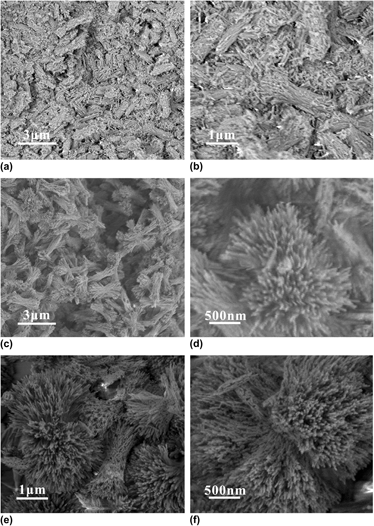Articles
The effects of electropulsing on the recrystallization behavior of rolled pure tungsten
-
- Published online by Cambridge University Press:
- 19 September 2012, pp. 2630-2638
-
- Article
- Export citation
Microscale deformation of (001) and (100) rutile single crystals under spherical nanoindentation
-
- Published online by Cambridge University Press:
- 24 November 2011, pp. 53-63
-
- Article
- Export citation
Bending manipulation and measurements of fracture strength of silicon and oxidized silicon nanowires by atomic force microscopy
-
- Published online by Cambridge University Press:
- 08 November 2011, pp. 562-570
-
- Article
- Export citation
Polarity-induced ferroelectric crystalline phase in electrospun fibers of poly(vinylidene fluoride)/polyacrylonitrile blends
-
- Published online by Cambridge University Press:
- 21 March 2012, pp. 1389-1398
-
- Article
- Export citation
Effects of geometric and crystal structures on the photoelectrical properties of highly ordered TiO2 nanotube arrays
-
- Published online by Cambridge University Press:
- 16 February 2012, pp. 1029-1036
-
- Article
- Export citation
Structural and morphological characteristics of yttrium and lutetium orthoborates synthesized in thin layers of borate oxide glasses
-
- Published online by Cambridge University Press:
- 09 July 2012, pp. 2116-2121
-
- Article
- Export citation
Formation process of calcium vanadate nanorods and their electrochemical sensing properties
-
- Published online by Cambridge University Press:
- 31 July 2012, pp. 2391-2400
-
- Article
- Export citation
Excitonic transport in ZnO
-
- Published online by Cambridge University Press:
- 14 June 2012, pp. 2225-2231
-
- Article
- Export citation
Impact of low viscosity ionic liquid on PMMA–PVC–LiTFSI polymer electrolytes based on AC -impedance, dielectric behavior, and HATR–FTIR characteristics
-
- Published online by Cambridge University Press:
- 30 October 2012, pp. 2996-3004
-
- Article
- Export citation
Correlation between strain-rate-related mechanical properties of Zr-based metallic glass and casting temperature
-
- Published online by Cambridge University Press:
- 05 January 2012, pp. 701-708
-
- Article
- Export citation
Preparation, characterization, and luminescent properties of NaGd(WO4)2:Eu3+ nanotubes using carbon nanotubes as templates
-
- Published online by Cambridge University Press:
- 11 April 2012, pp. 1265-1270
-
- Article
- Export citation
Comparison of mechanical behaviors of enamel rod and interrod regions in enamel
-
- Published online by Cambridge University Press:
- 03 January 2012, pp. 448-456
-
- Article
- Export citation
Hydrothermal zinc oxide nanowire growth with different zinc salts
-
- Published online by Cambridge University Press:
- 02 August 2012, pp. 2401-2407
-
- Article
- Export citation
Nickel nanoparticles synthesized by a modified polyol method for the purification of histidine-tagged single-domain antibody ToxA5.1
-
- Published online by Cambridge University Press:
- 17 October 2012, pp. 2884-2890
-
- Article
- Export citation
Microstructure and compression behavior of chip consolidated magnesium
-
- Published online by Cambridge University Press:
- 12 January 2012, pp. 709-719
-
- Article
- Export citation
Spectral emittance of resistively heated oxidized ZrB2–30 mol% SiC
-
- Published online by Cambridge University Press:
- 11 July 2012, pp. 2520-2527
-
- Article
- Export citation
Electron transport in semiconducting SnO2: Intentional bulk donors and acceptors, the interface, and the surface
-
- Published online by Cambridge University Press:
- 12 June 2012, pp. 2232-2236
-
- Article
- Export citation
Intense optical absorption of defects created in Er3+-diffused layer in MgO (5 mol%)-doped LiNbO3 crystal by local Er3+ diffusion under Li-poor atmosphere
-
- Published online by Cambridge University Press:
- 26 April 2012, pp. 1482-1487
-
- Article
- Export citation
Oscillatory thickness dependences of the Seebeck coefficient in nanostructures based on compounds IV–VI
-
- Published online by Cambridge University Press:
- 16 February 2012, pp. 1157-1163
-
- Article
- Export citation
Development of a silicon oxide-based resistive memory device using a spin-on hydrogen silsesquioxane precursor
-
- Published online by Cambridge University Press:
- 05 December 2012, pp. 3110-3116
-
- Article
- Export citation



 > slip systems. In the (100) orientation, only two of the four {101}<10
> slip systems. In the (100) orientation, only two of the four {101}<10 > slip systems, along with {100}<0
> slip systems, along with {100}<0 0> slip, are activated. Because the four {101}<10
0> slip, are activated. Because the four {101}<10 > slip systems in the (001) orientation intersect, the surface is harder and exhibits higher hardening rates after the nucleation of dislocations. The latter are manifested by pop-ins, some of which are large. The pop-in stresses are adequately described by Weibull statistics and were significantly higher for the (001) orientation. The elastic moduli, determined from spherical NI stiffness versus contact radii plots, were 349 ± 5 and 229 ± 4 GPa for (001) and (100) orientations, respectively. Fully spontaneous reversible, stress–strain hysteretic curves—only manifest in the (100) orientation—are attributed to the to-and-fro motion of dislocations comprising incipient kink bands in the {100}<0
> slip systems in the (001) orientation intersect, the surface is harder and exhibits higher hardening rates after the nucleation of dislocations. The latter are manifested by pop-ins, some of which are large. The pop-in stresses are adequately described by Weibull statistics and were significantly higher for the (001) orientation. The elastic moduli, determined from spherical NI stiffness versus contact radii plots, were 349 ± 5 and 229 ± 4 GPa for (001) and (100) orientations, respectively. Fully spontaneous reversible, stress–strain hysteretic curves—only manifest in the (100) orientation—are attributed to the to-and-fro motion of dislocations comprising incipient kink bands in the {100}<0 0> slip system.
0> slip system.
















